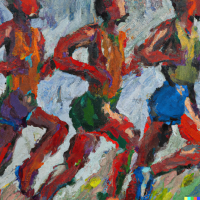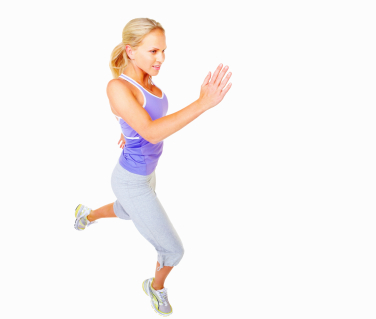Eight Different Running Workouts - Why and How You Need to Do These Workouts
Want to learn a lot of different running workouts?Then this may be just the page for you.

Because every type of running helps your body in a different way.
At different running speeds, different body systems get stressed in different ways.
So, when aiming to get better, it is a must that:
a) You have an understanding of why you do different workouts.
b) You do them!.... :)
Also have a look at this video, which explains why we do different types of workouts:
Please check out the info below. And click on the links for more information.
When Does A Training Run Become a Workout?
Basically, workouts are any type of runs that include faster running. This can be structured (e.g. run faster for a certain time or distance) or unstructured (e.g. run fast from one letterbox to the next).
On this page, purely to be a bit more complete, I am starting the conversation with easy running, which is not a workout. But because it should entail about 70-90% of your running, I thought we might as well start there!
How Many Workouts Should You Do Per Week?

The number of workouts you do in a week is generally 1 or 2, but can sometimes be 0 and also possibly be as high as 3.
When would you do 0 workouts per week?
When you are new to running or in a period of pure base building, only consisting of easy running, then you would do 0 workouts per week. Not doing any workouts at all is a bit boring, so that's why most of us build in a day of tempo running here and there into our base building period.
When would you do 3 workouts per week?
Let's start with the statement that three workouts is a lot. It is only advisable for more advanced runners who run 5, 6 days per week. And even then, only as part of a structured running program in which most of the training weeks only include 1 or 2 workouts per week.
But if we define workouts as any type of running that is faster, then an advanced runner's schedule for a week could look like this:
Mon: Easy
Tue: Workout 1: Tempo Run
Wed: Easy
Thu: Workout 2: Intervals
Fri: Easy
Sat: Easy
Sun: Workout 3: Long Run with part of the run at Goal Pace
This could be a schedule for a marathon or half marathon runner in a tough week. Variations are possible. But you get the idea. This is one way to get to three workouts per week.
It is almost impossible to define a rule that should apply to everyone. But I would not recommend three workouts if your workload is lower than 5, 6 days per week. You are most likely better off with more easy running rather than faster running.
When would you do 1 or 2 workouts?
In almost any other circumstance that is not described above!
Now, let's get to the workouts and non-workouts!
Running Non-Workout #1: Easy Running - Building Your Base

Flaw in the foundations of a building? Then the building will start to show cracks. It may even come tumbling down.
Similarly, if your running can't rely on a solid base, then it is almost useless having speedy legs. Being fast is great. But in middle and long distance running, you need to be fast for a long period of time. Without a base, you will be out of breath within minutes and eventually, you will have to slow down or stop.
Thus, easy running is very important to make sure that you have got sufficient depth and should always come before building speed.
Click on the link to learn more:
Base Running Drills - The Foundation of Your Running.
Running Workout #2: Tempo Running

We just established that building your base via easy running is the absolute number one priority. Tempo running follows closely behind!
Tempo running pace is traditionally defined as the pace we can run at for one hour. It is a steady, somewhat uncomfortable pace. For faster runners it is close to half marathon pace, for middle of the pack runners it is close to 15k pace and for slower runners it may be more closely aligned to 10k pace.
As we learn more about the ways famous runners train, whether it is the Kenyans or the Norwegians, we can see that tempo running is an important part of their running programs.
A tempo run will effectively help your body get used to moving at a constant reasonably fast rate for a period of time. Tempo running is also known as lactate treshold pace. Because you run at a pace, just below the point that you have significant lactic acid build-up in your legs. The reason this pace is so useful, is that it trains your body to get more effective at moving lactic acid.
Click on the link to learn more:
Tempo Running - Reasons Why We Do It and Top Tempo Workouts Explained
Running Workout #3: Interval running
Interval running is running at anaerobic pace. Interval running is taxing for the body. Interval workouts bring results however, so you should incorporate them in your running program!
The main reason behind doing interval runs is to train your muscles in taking up oxygen from the blood. At high speed, your heart is required to work harder. It pumps more blood (with in it oxygen) to your muscles. Your muscles then need to make sure they absorb that oxygen as well as possible, so they can continue functioning well.
Before you start doing intervals, my recommendation is that you should be able to run at easy pace for at least 45 minutes to an hour.
You may feel that you want to do intervals earlier on. It's your choice. I make this recommendation in order to highlight how important easy running and tempo running are. Without a strong foundation, intervals are a little less useful.
Interval sessions are taxing, hard sessions. Too many of them in a week will make it too hard to put other tough workouts (long runs, lactate treshold runs) into your running schedule. So, I'd always recommend that you do a maximum of one interval session per week.
Click on the link to learn more:
Interval Running - The Workout You Love and Hate
Running Workout #4: Fartlek
 Fartlek is a good
introduction to
running speed workouts for beginners.
Fartlek is a good
introduction to
running speed workouts for beginners. The principle of fartlek is that you just go out there, warm up, and then start running.
You run at varying speeds for varying periods of time.
You finish up with an easy paced cooling down.
There are several ways to do it.
Every fartlek session is different. An example is running 5-4-3-2-1 minute sessions with 2 minutes of floating in between (floating = keeping up to moderate speed, so no recovery jog or walking).
But it can be way more free-flowing as well, allowing you to speed up and float when you feel it is necessary.
It's a an excellent way to build up a feel for speed workouts.
Click on the link to learn more. On that page I have also included a special workout from Australian long distance runner Steve Moneghetti:
Fartlek Workouts -- Speed Play for Beginners (and the Advanced!)
Running Workout #5: Goal Pace Running

Doing goal pace running will prepare you for a tough race day and will give you an idea about whether your goals are attainable or not.
Click on the link to learn more:
Key to Success :: Goal Pace Running
Running Workout #6: Billat's 4 x 5
Veronique Billat is an expert on how to improve running performance. She is a fast half marathoner herself (sub 1:20), coach of top runners in France, and a renowned exercise physiologist.

It is simple. Run four times for five minutes with a 2 1/2 minute recovery jog in between. You should do this workout at a pace between tempo and interval pace. This is normally close to 5K race speed. It is a tough workout, but worth it.
Click on the link to learn more:
Special Running Workouts: Billat's Four by Five and the Thirty-Thirty
Running Workout #7: Yasso 800

The time you spend running these 800 metres in minutes, is a prediction of how fast you can run your marathon in hours. So, say you do your Yasso 800s at 3:30 min / 800 metres. In between you recovery jog for the same amount of time (so 3:30 min). Then your predicted marathon time is 3:30 hours. Doing your 800 metre-repeats at 2:50 min / 800 metres (recovery jog for 2:50 min)? Then your predicted marathon time is 2 hours and 50 minutes.
The Yasso 800 is a good workout although its predictiveness can be questioned.
Click on the link to learn more:
Yasso 800 :: The Marathon Pace Workout with a Twist
Running Workout #8: Running Strides
Hmm, do strides count as a workout? Well, I am going to include them here. Not enough runners I know do them consistently. And they are important. So, given they are done at a higher speed, I am going to call them a workout for the purposes of this page.

For long distance runners who focus a lot on logging slow, easy miles, strides are essential. They more or less help to remind your legs how to be speedy :)
Strides help to improve your running economy. That's basically the amount of energy you use when running. The less energy you use, the longer you can go.
Another reason why you do strides is that typically at the end of a race you once more try to give it all you got and pick up the pace. Strides simulate that.
Click on the link to learn more:
Why Running Strides Makes You Faster

There are all kinds of variations you can do. Just to cover off on a few of them:
You can combine tempos and intervals into one session. E.g. 20 minutes tempo, followed by 10 x 1 min intervals.
Progressive long runs or long runs with a faster finish. You can start a run by running easy and then going progressively faster or you can include a fast finish (e.g. 15 mile long run with last 3 miles at tempo pace).
Etc., etc. in the end, most of it boils down to the running workouts described on this page or variations thereof.
Workouts are the cooler part of your running program. And properly done, as part of a complete running program, running workouts will help you reach top performance. However, just keep in mind that easy running remains the most important part of your training. Without a strong, strong base, all these cool workouts can only do so much in making you a better runner!
Home > Running Training > Running Workouts Page




